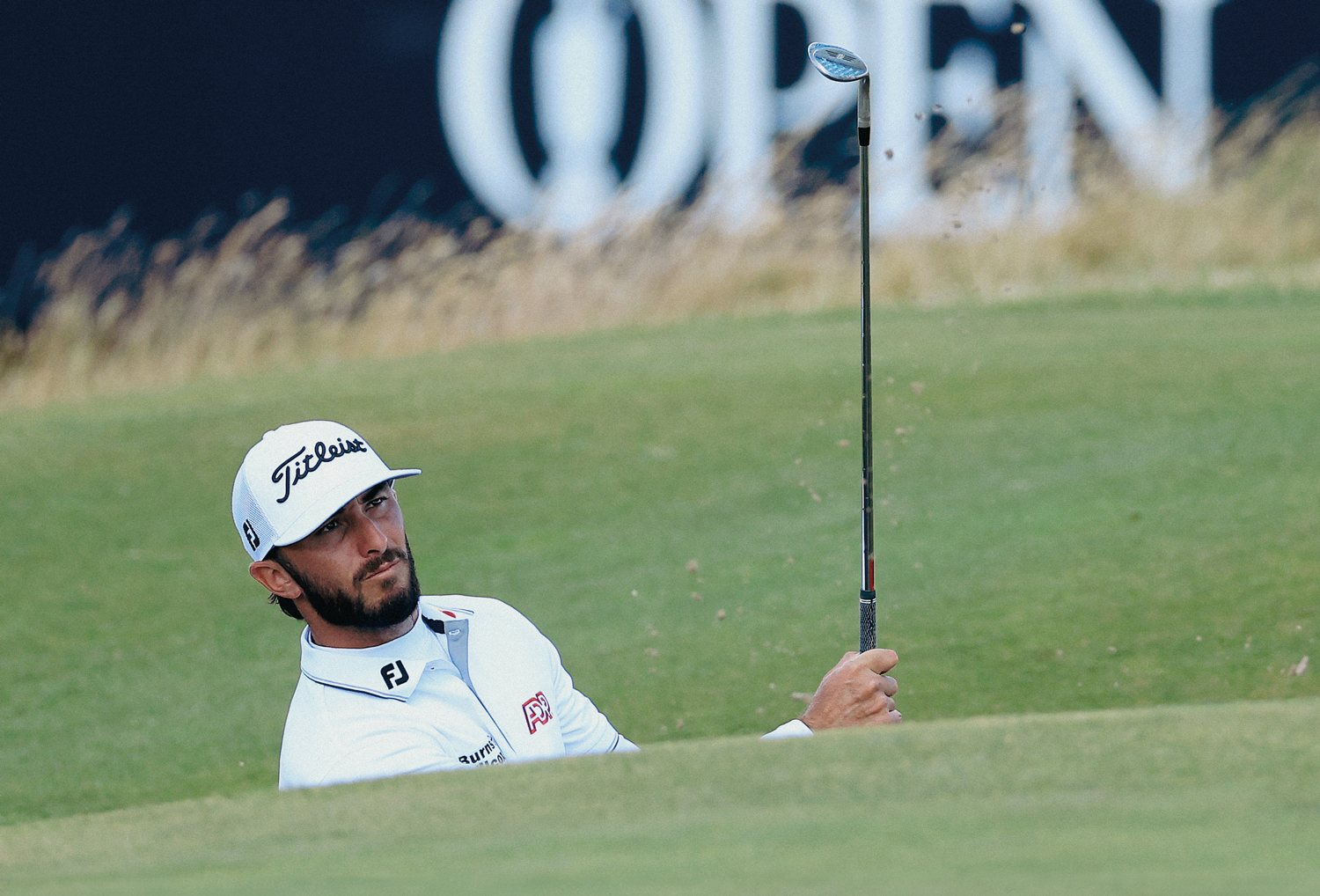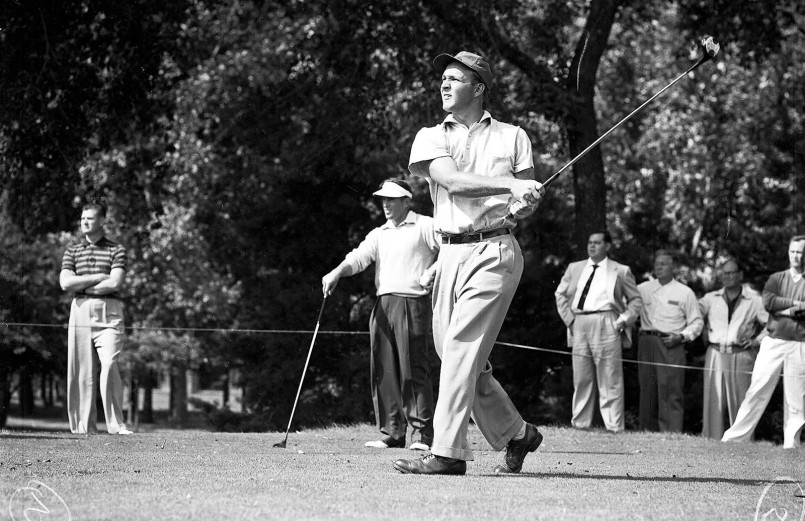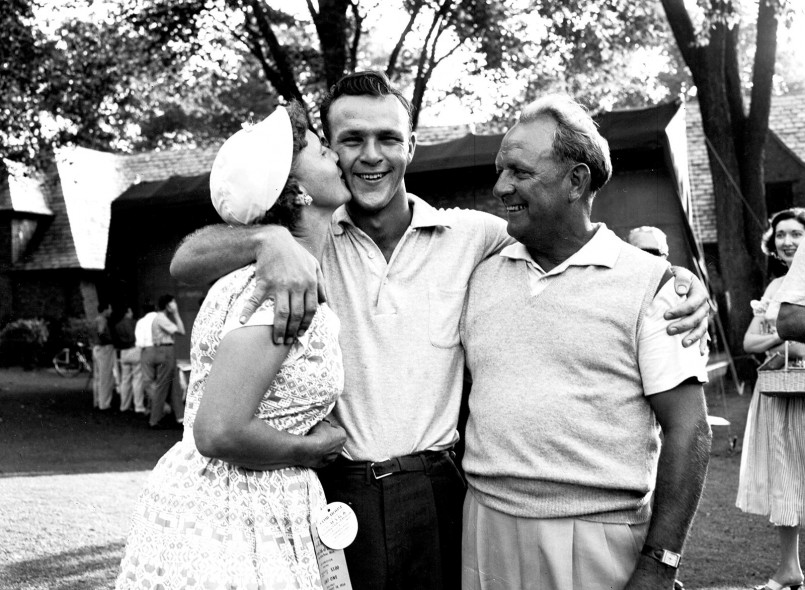
Jimmy Gill, Arnold Palmer’s 16-year-old caddy during the 1954 U.S. Amateur at The Country Club of Detroit, remembered a very businesslike Palmer that week, arriving at the practice tee by 7 every morning and working on the putting green after each round.
“He was great beyond six feet, but pretty erratic inside six feet,” Gill recalled years later. “But he was bold on every putt. He would never be short.”
The teenager was particularly impressed with the way Palmer hit his long irons.
“He was so strong, big shoulders and arms, and he was so confident,” Gill said. “He was a gambler. He’d just go for it. If he missed a shot he knew he could make it up later. He had something about him. That walk of his, the way he attacked the ball.”
It is a vivid portrait of the 24-year-old Palmer, who 60 years ago this August outlasted a valiant Robert Sweeny, Jr. in a taut, exhausting championship match.

Sweeny, the 43-year-old “graying millionaire,” conceded on the 36th and final hole after losing his tee-shot in tall grass. It was a splendid moment for Palmer, though at the time no one could have guessed at the significance. The victory would not only transform his life and career, it would change the professional and amateur games in ways unimaginable.
“That’s where it all began,” Palmer once said.
He was referring to his own path, but could have just as easily been talking about modern golf.
The Country Club of Detroit in Grosse Pointe Farms, just north of the Detroit border, became one of the game’s sacred grounds. To this day, the aura of Arnie’s Amateur fills every oak-encrusted nook and cranny of the place, from the men’s grill to the locker room to the high-ceilinged banquet hall where a few years later Henry Ford II would stage debutante balls for his daughters.
The championship match on Saturday, August 24 was billed as a “battle of the classes.” The young paint salesman, seven months out of the Coast Guard, versus the son of a prosperous American investment banker.
Sweeny, winner of the 1937 British Amateur, was born in California, raised in New York, and followed his older brother Charles to Oxford. With his combination of golfing genius, easy charm and movie-star looks he became a fixture in British society.
Palmer literally grew up on a golf course. At 7 he was learning to drive the tractor at Latrobe Country Club, where his father was club pro and greenkeeper.
“We hailed from different galaxies,” said Palmer.
Sweeny, a slender 6-foot-3 with dark, wavy hair, was among the last of the game’s Great Gatsbys. He was a cool socialite with a mother-of-pearl swing, shuttling between homes in London, Long Island and Palm Beach, squiring the most beautiful women, and playing the most beautiful golf.
Battling Palmer in Detroit, he made the last stand of the game’s old aristocracy against its new merchant class. He personified the Bobby Jones era, the age of the patrician amateur. He was aristocrat enough to play with the Duke of Windsor, charming enough to tee it up with Hollywood stars, and skillful enough to battle Ben Hogan for $10 Nassaus at Seminole, one of his home courses.
His friend the actress Merle Oberon followed in the gallery as he won the British Amateur at Royal St. George’s. In Sport of Princes: Reflections of a Golfer, Laddie Lucas described Bobby as “hovering like some superior bird-of-prey over this pre- and post-war scene. Spare, good-looking, and invariably well-dressed in well-cut clothes, Bobby Sweeny was a commandingly able player. He also danced as impressively as he swung a golf club.”
Bruce Critchley, the British TV golf analyst who played with Sweeny at Sunningdale in the 1960s, said: “He was a beautiful player. I remember seeing him hit a 2 wood off a barren lie. It was just astonishing skill. There was no rush to his game, just elegance; nothing but elegance. It was the way he lived his life. It was his style in everything.”
Palmer called him “the finest swinger and striker of the ball I’d ever seen. If I’d been able to see Bobby Jones play, I imagine he’d swing like Bob Sweeny.”
Of course, Palmer also was a highly regarded player in 1954, having won the All-American Amateur at Tam O’Shanter in Chicago earlier in the year. But he was not expected to win in Detroit. Teenage caddie Lew Echlin carried Palmer’s bag in a practice round and wanted no more of the job. Instead, Echlin chose to work the scoreboard for $2.50 an hour.
Palmer did not exactly waltz through the opposition when the tournament started. His opening round win over seven-time New York metropolitan champ Frank Strafaci came on the 17th hole. The next day Palmer needed the full 18 to get by Florida State’s John Veghte. On Wednesday morning he defeated 31-year-old Richard Whiting, captain of the 1946 Notre Dame team, on the 17th. In the afternoon he knocked off 35-year-old Walter Andzel of Hamburg, New York, 5&3, and got off the course before a thunderstorm hit.

Still, Palmer’s triumphs weren’t getting much attention. The biggest gallery on Wednesday followed pre-tournament favorite Frank Stranahan and Harvie Ward. Stranahan, the power-lifting 32-year-old heir to the Champion Spark Plugs fortune, managed an exciting one-up victory.
Known as “Muscles” and the “Toledo Strongman,” Stranahan would meet Palmer on Thursday. Indeed, the two friends were fast becoming old foes. Stranahan had disposed of Palmer 4&3 in the 1950 Amateur and 11&10 in a 36-hole North and South semi-final. A week before Detroit, he had won the World Amateur in Chicago, with Palmer finishing second.
This time Palmer was ready. He played better than he had all week and pulled out a 3&1 victory. He was surviving the tournament’s toughest bracket, which besides Stranahan included 1954 Masters sensation Billy Joe Patton, former U.S. Amateur champion Charlie Coe and Harvie Ward, who would win the tournament in 1955. They had all been eliminated and now the paint salesman was the tournament favorite.
In the afternoon, Palmer met 1953 Canadian Amateur champion Don Cherry, a professional singer from Texas who performed at the Dakota Inn in Detroit the night before. Palmer’s victory on the 17th hole sent him into the semi-final on Friday against Edward Meister, Jr., a 36-year-old former Yale golf captain.
There would have been no duel in the sun with Sweeny had it not been for an heroic shot in that tense, marathon semi-final.
Palmer was one-up after 18, though neither man played particularly well in the morning. Both recorded double-bogey sixes at the 18th. A local sportswriter reported: “The contestants hit shots that cheered the hearts of duffers in the gallery.”
Play improved after lunch, though neither could build much of a lead. With the match all square going to the 36th hole, Palmer would play what may be the single most important hole in his life—certainly it was up to that point.
Meister ripped his drive down the middle of the 18th fairway and then punched a 5-iron to eight feet. Palmer’s tee shot flew into the rough and his second bounded over the green into a swale behind the green. The ball was barely visible in the deep grass and Palmer had little green to work with as he faced a tricky pitch onto a slippery slope that slanted severely away from him. He’d have to make the ball stop quickly. Meister, studying a makeable birdie putt, hovered above.
Palmer slipped a wedge under the ball, causing it to land softly on the fringe and then trickle down the slope, stopping four feet from the hole.
“I doubt that Arnold ever hit a more miraculous shot”
“I doubt that Arnold ever hit a more miraculous shot,” Mark McCormack wrote. A monument is placed on the spot where the ball lay buried in tall grass behind the 18th green.
Meister missed his birdie try, but Palmer still had to make his slick side-hill four-footer to extend the match. He deliberated long and hard over the putt.
“If I missed it, being short would have not done me any good,” Palmer said.
“It was a crucial putt needless to say. My best recollection is that it was a straight-in putt, straight in the hole and that is what happened.”
In overtime, Meister missed putts of 10, eight, five and 16 feet—any one of which would have prevented Palmer from reaching the final.
On the 39th hole, the 510-yard par-five 3rd, Palmer unleashed a 300-yard drive with his trademark ball flight—one of those upside-down spoon-shaped tee-shots that he made famous with his slashing swing. He then nailed a low, whistling 3-iron that ended up 30 feet from the pin and two-putted for birdie and victory, putting an end to the longest semi-final in U.S. Amateur history.
The showdown with Sweeny was set for the next day, August 28, 1954. A wire photo that ran in newspapers across America that morning showed a grinning Palmer in shirtsleeves and a pokerfaced Sweeny in suit and tie with their hands on the trophy, and the caption: “They’ll play for this today.”

A gallery of 3,500 followed the match in warm, sunny weather, including Palmer’s mother and father.
Although Sweeny towered over his 5-foot-11 foe, Palmer out-drove his opponent by as much as 40 yards on some holes. But Sweeny, superb with the short stick, built an early lead by sinking a series of epic putts—a 35-footer on the second green and 20- and 25-foot big benders on the third and fourth.
Dazed and disheartened, Palmer recalled in A Golfer’s Life that as the two players started down the fourth fairway a “beautiful girl following Sweeny suddenly came through the ropes and out onto the fairway and waltzed right into his arms, giving him a real double-feature kiss.
“I remembered watching them in disbelief, and maybe a little envy, thinking what a cruel game golf could be. Here I was, getting pasted in the tournament I’d always dreamed of winning, and my opponent was not only rich and handsome and hitting perfect golf shots but getting the girl as well.”
But after the two men hit their drives on the fifth tee, Sweeny threw an arm around Palmer and said, “Arnie, you know I can’t keep this up.”
He did for a while, though. On the seventh hole Palmer took a bogey five to give Sweeny a three-up lead at that point.
But in the hot, sticky August—and after five grueling days of match play—the older man began to wilt. With a par on the 32nd, Palmer went ahead for the first time in the match. He birdied the next hole to go two-up, with Sweeny’s own 12-foot birdie try spinning out of the cup.
Dog-tired, Sweeny came back to halve the next hole and win the 35th with a 15-footer to send the match to the 36th and final hole. First up, Sweeny drove into the thick grass on the right. With sweaty palms, Palmer stepped up.
“I became very nervous at that point,” he said. “I was very cautious.”
He laced his tee ball 250 yards down the right side of the fairway.
The match never made it to the green. After searching for his ball for a few minutes, Sweeny gave up. He walked over to Palmer and said, “Congratulations, Arnie, you win.”
Palmer threw an arm around Jimmy Gill and then gave his mother Doris a hug. He began to look for his father, Deacon Palmer, who was hanging back.
Finally, Pap walked up and said: “You did pretty good, boy.”
Of Sweeny, Palmer said: “I don’t know if he’s the greatest putter in the world, but he sure was firing them at me today.”
The questions started. Would he turn pro immediately?
“I like selling paint,” Palmer told a reporter.
Still, some observers thought they caught a glimpse of the future. John Dietrich of the Cleveland Plain Dealer wrote: “This was the birth of a new super champion.”
But first things first: A week after the tournament Palmer met Winifred Walzer in Shawnee-on-the-Delaware, Pennsylvania, where he played in bandleader Fred Waring’s annual invitational. They were soon married and Palmer made his decision to become a professional. He played in his first Masters the following April.

Follow Us On


| Cookie | Duration | Description |
|---|---|---|
| cookielawinfo-checkbox-analytics | 11 months | This cookie is set by GDPR Cookie Consent plugin. The cookie is used to store the user consent for the cookies in the category "Analytics". |
| cookielawinfo-checkbox-functional | 11 months | The cookie is set by GDPR cookie consent to record the user consent for the cookies in the category "Functional". |
| cookielawinfo-checkbox-necessary | 11 months | This cookie is set by GDPR Cookie Consent plugin. The cookies is used to store the user consent for the cookies in the category "Necessary". |
| cookielawinfo-checkbox-others | 11 months | This cookie is set by GDPR Cookie Consent plugin. The cookie is used to store the user consent for the cookies in the category "Other. |
| cookielawinfo-checkbox-performance | 11 months | This cookie is set by GDPR Cookie Consent plugin. The cookie is used to store the user consent for the cookies in the category "Performance". |
| viewed_cookie_policy | 11 months | The cookie is set by the GDPR Cookie Consent plugin and is used to store whether or not user has consented to the use of cookies. It does not store any personal data. |